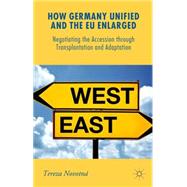
How Germany Unified and the EU Enlarged Negotiating the Accession through Transplantation and Adaptation
by Novotná, Tereza-

This Item Qualifies for Free Shipping!*
*Excludes marketplace orders.
Buy New
Rent Textbook
Rent Digital
Used Textbook
We're Sorry
Sold Out
How Marketplace Works:
- This item is offered by an independent seller and not shipped from our warehouse
- Item details like edition and cover design may differ from our description; see seller's comments before ordering.
- Sellers much confirm and ship within two business days; otherwise, the order will be cancelled and refunded.
- Marketplace purchases cannot be returned to eCampus.com. Contact the seller directly for inquiries; if no response within two days, contact customer service.
- Additional shipping costs apply to Marketplace purchases. Review shipping costs at checkout.
Summary
Author Biography
Table of Contents
LIST OF TABLES
LIST OF FIGURES
ACKNOWLEDGEMENTS
LIST OF ABBREVIATIONS
1 CHAPTER 1: POLITICAL INTEGRATION IN EUROPE AFTER 1989: AN INTRODUCTION
1.1 MAIN AIMS AND THEMES OF THE BOOK
1.2 NATURE OF THE RESEARCH AND METHODOLOGY OF THE BOOK
1.3 STRUCTURE OF THE BOOK
2 CHAPTER 2: TRANSPLANTATION AND ADAPTATION MODELS OF POLITICAL INTEGRATION: A THEORETICAL FRAMEWORK
2.1 THEORETICAL FRAMEWORK I: GENERAL CHARACTERISTICS OF TWO MODELS OF POLITICAL INTEGRATION 11
2.1.1 Speed and Timing of the Transplantation Model of Political Integration
2.1.2 Strong Leadership and Procedural Character of the Transplantation Model of Political Integration
2.1.3 Speed and Conditionality of the Adaptation Model of Political Integration
2.1.4 Bureaucratic Leadership and Consensual Character of the Adaptation Model of Political Integration
2.2 THEORETICAL FRAMEWORK II: PROCESSES OF TWO MODELS OF POLITICAL INTEGRATION
2.2.1 Institutional, Economic, and Elite Transfers as the Basis for Implementing the Transplantation Model of Political Integration
2.2.2 Institutional, Economic, and Elite Building as the Basis for Implementing the Adaptation Model of Political Integration
2.3 SPEED AND IMPACT OF THE DOMESTIC ACTORS: TWO MAIN DISTINGUISHING FEATURES OF THE TWO MODELS OF POLITICAL INTEGRATION
2.4 CONCLUSION
3 CHAPTER 3: THE UNIFICATION OF GERMANY: A CASE OF THE TRANSPLANTATION MODEL OF POLITICAL INTEGRATION
3.1 THE TRANSPLANTATION MODEL OF POLITICAL INTEGRATION CLARIFIED: SPEED AND IMPACT OF THE DOMESTIC ACTORS DURING THE UNIFICATION OF GERMANY
3.2 TEARING DOWN THE BERLIN WALL: DEMOCRATIZATION VS. INTEGRATION
3.2.1 Local Actors I: Masses
3.2.2 Local Actors II: The Reform Communists
3.2.3 The Wall and Kohl: the External Actors
3.2.4 Local Actors III: The Opposition
3.2.5 'Vor der Einheit kam die Freiheit' (Gauck)
3.3 THE 10 POINT PROGRAM – ENTER KOHL : A STRONG LEADER IN CHARGE
3.4 THE MARCH 1990 VOLKSKAMMER ELECTIONS: TRANSPLANTING THE PARTY SYSTEM
3.4.1 The Unification of the CDU and the Allianz für Deutschland
3.4.2 Campaign
3.4.3 Results
3.4.4 Formation of the New East German Government
3.5 ECONOMIC AND MONETARY UNION AND THE STATE TREATY – PUTTING THE FOOT ON THE GAS: TRANSPLANTING THE ECONOMICS
3.5.1 Key drivers of the process
3.5.2 Key Decisions
3.5.3 The Consequences of the Economic Transplantation
3.6 GERMAN UNIFICATION ACT I: CONCLUSION
4 CHAPTER 4: NEGOTIATING THE EAST GERMAN ACCESSION: ACT II OF GERMAN UNIFICATION
4.1 ELECTIONS AND UNIFICATION: DISPUTES OVER DATES AND LAWS
4.2 NEGOTIATIONS
4.3 MISSED AND TAKEN OPPORTUNITIES: THE IMPACT OF THE EAST ON THE NEGOTIATIONS
4.4 MORE INTERNATIONAL NEGOTIATIONS, EVEN LESS IMPACT
4.5 GERMAN UNIFICATION ACT II: CONCLUSION
5 CHAPTER 5: EASTERN ENLARGEMENT OF THE EU: A CASE OF THE ADAPTATION MODEL OF POLITICAL INTEGRATION
5.1 THE ADAPTATION MODEL OF POLITICAL INTEGRATION CLARIFIED: A SLOWER AND VARIABLE SPEED AND HIGHER IMPACT OF THE DOMESTIC ACTORS DURING THE EASTERN ENLARGEMENT OF THE EU
5.2 THE WINDS OF CHANGE AND RETURN TO EUROPE: AN OVERTURE TO THE ENLARGEMENT
5.3 COPENHAGEN CRITERIA: A FOUR-POINT PROGRAM OF POLITICAL CONDITIONALITY
5.4 FROM COPENHAGEN TO NICE VIA LUXEMBOURG AND HELSINKI: ADAPTING TO THE PROSPECT OF ENLARGEMENT
5.5 THE COMMISSION AND PRE-ACCESSION PROGRAMS: FINANCING AND ASSESSING THE INSTITUTION BUILDING
5.6 EU EASTERN ENLARGEMENT ACT I: CONCLUSION
6 CHAPTER 6: NEGOTIATING THE CZECH ACCESSION TO THE EU: ACT II OF EU EASTERN ENLARGEMENT
6.1 THE NEGOTIATIONS, THEIR STRUCTURES, AND THE IMPACT OF THE ENTERING COUNTRIES
6.1.1 Power Asymmetry of the EU Accession Negotiations
6.1.2 Negotiations at the Accepting EU Side
6.1.3 Structure of Negotiations
6.1.4 Role of the Rotating Presidency and the Commission During Negotiations
6.1.5 The Applicants' Chief Negotiators
6.1.6 Negotiating Tactics
6.2 COORDINATING THE CZECH POSITION AT HOME AND ABROAD
6.2.1 Coordination at Home
6.2.2 Coordination Abroad
6.3 POLITICAL VS. TECHNICAL ISSUES
6.3.1 Negotiating the Technical Issues: Chapters and Transition Periods
6.3.2 Negotiating the Political Issues: Temelín and Beneš Decrees
6.4 THE COPENHAGEN SUMMIT AND ITS AFTERMATH
6.4.1 Negotiating at the Copenhagen Summit
6.4.2 Negotiating the EU Accession at Home
6.5 EU EASTERN ENLARGEMENT ACT II: CONCLUSION
7 CHAPTER 7: EVALUATING THE UNIFICATION OF GERMANY AND THE EASTERN ENLARGEMENT OF THE EU
7.1 WE THE PEOPLE: THE PUBLIC'S EVALUATION OF POLITICAL INTEGRATION
7.2 THE VIEW FROM THE TOP: THE ELITES' EVALUATION OF POLITICAL INTEGRATION
7.3 CONCLUSION
8 CHAPTER 8: LESSONS LEARNED FROM THE TRANSPLANTATION AND ADAPTATION MODELS OF POLITICAL INTEGRATION: A CONCLUSION
LIST OF INTERVIEWS:
THE UNIFICATION OF GERMANY
EASTERN ENLARGEMENT OF THE EU
BIBLIOGRAPHY
An electronic version of this book is available through VitalSource.
This book is viewable on PC, Mac, iPhone, iPad, iPod Touch, and most smartphones.
By purchasing, you will be able to view this book online, as well as download it, for the chosen number of days.
Digital License
You are licensing a digital product for a set duration. Durations are set forth in the product description, with "Lifetime" typically meaning five (5) years of online access and permanent download to a supported device. All licenses are non-transferable.
More details can be found here.
A downloadable version of this book is available through the eCampus Reader or compatible Adobe readers.
Applications are available on iOS, Android, PC, Mac, and Windows Mobile platforms.
Please view the compatibility matrix prior to purchase.